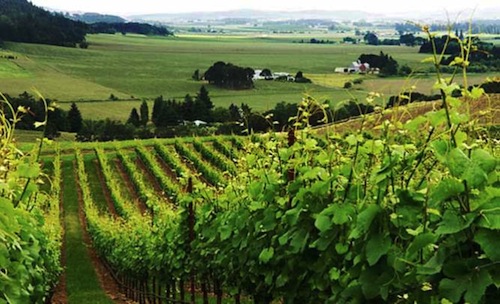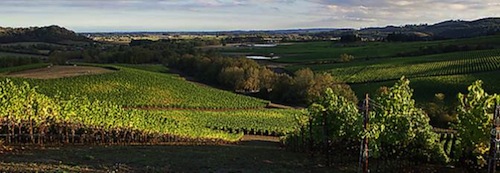
DUNDEE, Ore. – With the first harvest barely in the cellar, Erath Winery‘s Gary Horner could not be more ebullient about the grapes he received from Willakia, his new estate vineyard.
“The opportunity to do something special from there is pretty exciting,” the longtime Erath winemaker enthusiastically told Great Northwest Wine. “It’s insane, really.”
Ste. Michelle Wine Estates purchased Willakia in March, making it the Woodinville, Wash., company’s first Oregon vineyard. The property in the Eola-Amity Hills northwest of Salem is 298 acres in size, with 119 acres planted: 98 acres of Pinot Noir and 21 acres of Chardonnay. About 30 more acres are plantable.
Horner has more than 40 wines from Willakia that he currently is keeping separate, and he plans to produce at least one Willakia bottling – likely more – from the historically warm 2014 vintage.
“There are some radically different wines from there,” he said. “I’ll certainly do a single-vineyard wine, and I’ll probably do some block designates.”
Erath Winery’s vast Pinot Noir selection
Horner knows a bit about doing vineyard-designated Pinot Noirs, as he already has 13 of them in his portfolio, along with four other Pinots.
“It’s being driven by Gary,” said Ted Baseler, CEO of Ste. Michelle Wine Estates. “His interest is showing the uniqueness of the vineyards.”
No other winemaker in the extensive Ste. Michelle family would seem to have this kind of latitude in making so many different examples of a single variety. But this is the nature of Oregon Pinot Noir – and Horner.
Erath was launched in 1972 by Dick Erath, making it one of Oregon’s oldest and most revered properties. In 2006, Erath sold the winery to Ste. Michelle – though Baseler says the company is merely the custodian of an operation that would seem to transcend ownership.
After the purchase, Ste. Michelle told Horner – who joined Erath in 2003 – to ask for any and all equipment he could dream of. With these new tools in hand, Horner has more than doubled production to at least 150,000 cases since 2006.
Now with Willakia Vineyard, he could see an increase of nearly 20,000 cases. And Horner has the full support of his bosses in whatever direction he wants to take the new wines.
New potential from Willakia Vineyard

Doug Gore, senior vice president for winemaking and viticulture for Ste. Michelle, came to Dundee to taste through the new Willakia wines not long after fermentations finished.
“I had Doug down here,” Horner said. “I said, ‘You gotta see where this is going because it is so unique and so good.’ His eyes lit up. You have huge expectations when you spend that kind of money on a vineyard.”
Gore was blown away.
“You hear about it, you research it, and then you get the grapes,” Gore said. “This is delivering on what we thought it would do. It’s awesome. It opens up Gary’s range of styles into another dimension.”
Both Horner and Gore said the fruit coming from Willakia is not your typical Pinot Noir – at least not in 2014.
“It’s become apparent that this is a pigmented site,” Horner said with a quick laugh. “It’s like nothing else we have, with the exception of Bishop Creek. It falls outside of what I call ‘elegance.’ This is so not Dundee Hills. It’s hard to believe it’s the same variety.”
Gore agreed.
“We don’t get too hung up on color, but this is dark,” he said. “It’s a little bigger wine.”
Willakia Vineyard planted in 2001

Willakia – whose name derives from the site’s two prominent soil types, Willakenzie and Nekia – was first planted in 2001. It is sustainably farmed and certified LIVE and Salmon-Safe.
The vineyard faces west toward the legendary Van Duzer Corridor, a gap in the Coast Range that allows cool afternoon winds a direct line from the Pacific Ocean some 30 miles away.
“We saw the Van Duzer Corridor effect,” Horner said. “We definitely feel the impact of that. You can be in one block and feel the breeze and be in another block and not feel it at all. It was a good thing this year because (the cool winds) helped slow down ripening. In a cooler vintage, it is a later site because of that.”
In the past few years, several prominent Oregon vineyards have been sold to wine companies that are keeping all or significant portions of the fruit. And this trend is making access to quality grapes a premium. Though this had to weigh on Ste. Michelle’s mind, Gore said said that when Willakia Vineyard came up for sale, it was the right price at the right time.
“It was a chance to own an estate vineyard with a range of blocks,” he said. “We’re not going anywhere. We’re in Oregon for the long haul.”
Horner unwittingly purchased Chardonnay from Willakia Vineyard in 2013 – months before he knew he would have complete access to the vineyard.
“I spent a little time walking around in there in the ’13 vintage and was really impressed,” he said.
To be neighborly, Ste. Michelle did sell some of the Willakia fruit this fall to wineries that had been purchasing grapes prior to Ste. Michelle’s acquisition.
“We decided it was the right thing to do,” Gore said. “It gives people a chance to line up their sourcing (for future vintages). Three or four took us up on it.”
To prepare for what he might get, Horner bought wines made with Willakia fruit in previous vintages, as well as wines made from nearby vineyards. For example, Antica Terra Vineyard is adjacent to Willakia’s Block 17.
“Those matched up,” Horner said.
Ste. Michelle likely to build winery at Willakia Vineyard

In all, Horner brought in more than 300 tons of fruit from Willakia Vineyard , a number that could produce in the neighborhood of 18,000 cases of Pinot Noir and Chardonnay. While some of the Pinot Noir will find its way into Erath’s Estate Selection and some will likely end up in the vast Oregon tier, a significant amount will likely be broken down into separate lots.
How many remains to be seen. But Horner already does four separate wines from Prince Hill Vineyard in the Dundee Hills – a vineyard-designate and three clonal-designates.
“There are endless possibilities,” Horner said.
And Gore is quick to back him up.
“I’m not sure marketing has figured it all out yet,” he said with a laugh. “But I think it’s there if he wants to do a bunch (of bottlings).”
Gore said there’s plenty of room for creating wines limited to the tasting room or wine club members.
Ryan Pennington, who handles communications for Erath, said he anticipates an array of single-vineyard, single-clone and block-selection wines from Willakia Vineyard – for both Pinot Noir and Chardonnay.
Even though the winery anticipated a large increase in grapes from Willakia this fall, Horner chose to lease space at 12th and Maple Wine Co., a custom-crush facility not far from Erath’s facility in Dundee.
Gore sees this as a near-term solution, as he has high hopes that Ste. Michelle will build a facility at Willakia Vineyard.
“We love the site,” he said. “It’s a beautiful 300-degree view. We love the location, and we hope to build something on there someday – a high-end winery. We’re just looking at that now. It’s something we want to do in the future, so we’re still trying to figure it out.”
The vineyard is about 20 minutes south of Dundee and about 30 minutes northwest of the capital city of Salem.
“We’re excited about the property,” Gore said. “It brings a lot of good Pinot Noir into our program and allows us to get better. This fits right in with what we’re doing in Oregon.”

Leave a Reply